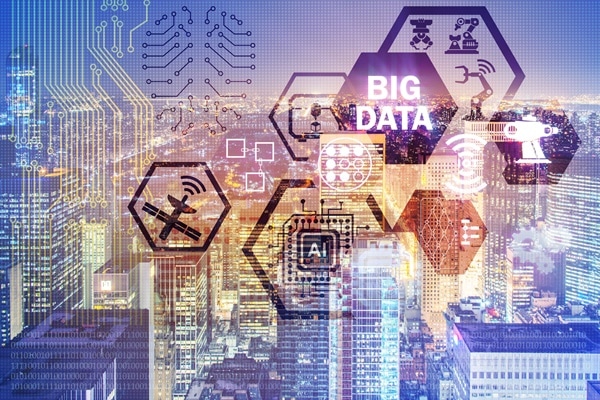Article by: Asst.Prof. Suwan Juntiwasarakij, Ph.D., MEGA Tech Senior Editor
แนวคิด Analytics of Things (AoT) หรือ Internet of Things Analytics (IoT Analytics) คือ หลักการประยุกต์ใช้เครื่องมือและกระบวนการทาง Data Analytics มาใช้เพื่อสร้างคุณค่าจากข้อมูลปริมาณมหาศาลที่สร้างโดยอุปกรณ์ IoT หลักการ AoT นี้จึงมีความหมายโดยนัยว่าหลักการ Analytics จำเป็นเพื่อที่จะทำให้อุปกรณ์ต่างๆ ที่เชื่อมต่อกันและเกิดการทำงานที่ชาญฉลาดได้
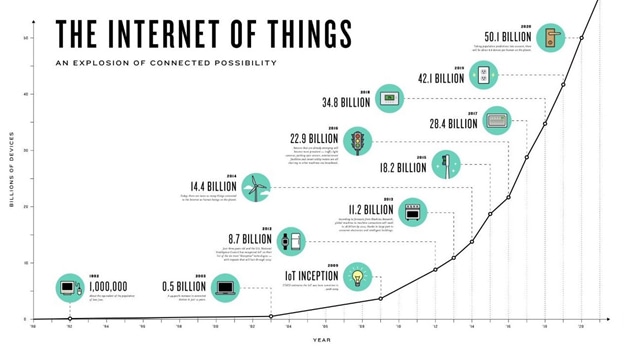
NCTA – The Internet & Television Association
มีการคาดการณ์ว่าตลาด IoT Analytics ของโลกจะเติบโตอย่างมากในช่วงปี 2019 – 2025 จากผลการวิเคราะห์ตลาด IoT Anaytics ในอเมริกาเหนือ ยุโรป เอเชียแปซิฟิก ตะวันออกกลาง แอฟริกา และแอฟริกาใต้ พบว่า ตลาดของอเมริกาเหนือมีความโดดเด่นและครองตลาดมากกว่าทุกภูมิภาค ทั้งนี้ เพราะมีอุตสาหกรรมค้าปลีก พาณิชย์อิเล็กทรอนิกส์ การผลิต การแพทย์และสุขภาพ การโทรคมนาคมสื่อสาร และเทคโนโลยีสารสนเทศ เป็นปัจจัยส่งผลักดัน
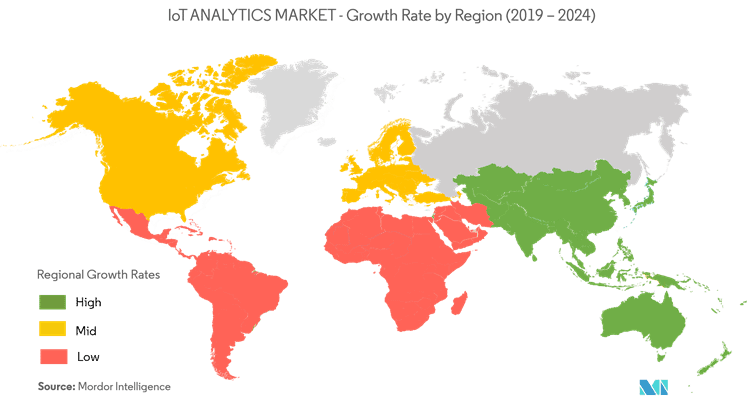
Source: Mordor Intelligence
ยิ่งไปกว่านั้นภูมิภาคอเมริกาเหนือมีโครงสร้างพื้นฐานที่ได้รับการพัฒนาขึ้นมาเป็นอย่างดี ซึ่งรวมถึงบ้านอัจฉริยะ โรงงานอัจฉริยะ ดังนั้น จึงเอื้อต่อการพัฒนาโซลูชันและเทคโนโลยีใหม่ๆ ออกมาสู่ตลาด ในส่วนของภูมิภาคเอเชียแปซิฟิก เมื่อพิจารณาดูแล้วจะพบว่าเอเชียแปซิฟิก เป็นภูมิภาคที่คาดการณ์กันว่าจะเต็มเร็วที่สุดในช่วง 2019 – 2025 อันเนื่องจากปัจจัย เช่น การพัฒนาโครงสร้างพื้นฐาน การประยุกต์ใช้อุปกรณ์ IoT ระบบคลาวด์ และเทคโนโลยีโซลูชันอื่นๆ จากอุตสาหกรรมการผลิตและจากภาคส่วนต่างๆ เป็นบ่อเกิดของข้อมูลปริมาณมหาศาล ดังนั้น จึงมีความจำเป็นอย่างยิ่งที่ต้องมีหลักการ IoT Analytics เพื่อทำการวิเคราะห์ข้อมูลเหล่านี้
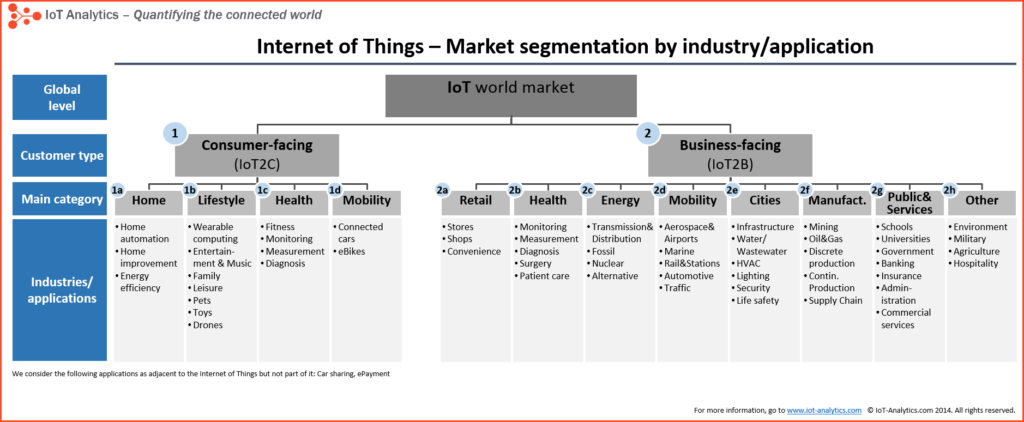
Source: IoT-Analytics.com
Mordor Intelligence ได้แบ่ง Segment ของตลาด IoT Analytics โดยใช้ (Solution, Service), Deployment (on Premise, Cloud), End-User Vertical (Agriculture, Energy & Utility, BFSI, Retail, Manufacturing, Public Sector), และ Geography และได้พยากรณ์ว่าตลาด IoT Analytics นี้จะเติบโตจาก 9.1 พันล้านเหรียญสหรัฐในปี 2018 ไปเป็น 58.4 พันล้านเหรียญสหรัฐในปี 2025 ด้วย CAGR ที่ 30.9% CAGR ตลอดช่วงเวลาพยากรณ์ ธุรกิจในอุตสาหกรรมการผลิตต่างก็ได้ใช้ Smart Sensor เพื่อเก็บเกี่ยวและรวบรวมข้อมูลที่เป็นกิจกรรมทางการผลิตที่เกิดขึ้นในสถานปฏิบัติการ ซึ่งในระยะต่อไปจะนำหลักการ IoT Analytics มาประยุกต์ใช้เพื่อสกัดและกลั่นกรองเป็นสารสนเทศที่จะย้อนกลับไปช่วยให้เกิดประสิทธิภาพต่อการปฏิบัติงานนั่นเอง หลักการ Analytics ทำให้ผู้ประกอบสามารถปรับแต่ระบบงานในสถานประกอบการ ช่วยทำให้การตัดสินใจของผู้ประกอบการได้ผลลัพธ์ที่ดีขึ้น
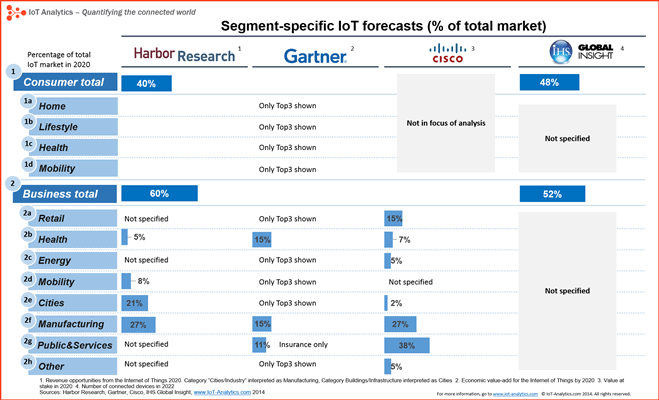
Source: IoT-Analytics.com
สิ่งที่ได้จากรายงานจำนวน 4 แห่งพบว่า การประยุกต์ใช้ IoT ในภาคธุรกิจ จะสูงกว่าการประยุกต์ใช้ IoT ในภาคผู้บริโภค (55% ต่อ 45%) โดยที่ภาคการผลิตจะเป็น Segment ที่ใหญ่ที่สุดและคาดว่ามีขนาดเป็น ¼ ของตลาด IoT รวม อุตสาหกรรมสุขภาพเองก็น่าจับตามองซึ่งคาดว่ามีขนาดระหว่าง 5%-15% ของตลาด อย่างไรก็ดี ยังไม่มีบทสรุปที่ลงตัวเกี่ยวกับอุตสาหกรรมการบริการในภาครัฐและภาคเอกชน
TAKE-HOME MESSAGE
โอกาสนานับไม่ถ้วนจะมาจากการลงทุนของรัฐในแต่ละประเทศ จำนวนโครงการไม่ว่าจะเป็นเมืองอัจฉริยะ บ้านอัจฉริยะ และโรงงานอัจฉริยะล้วนเป็นขุมพลังการเติบโตของตลาด IoT Analytics ระดับโลก และในหลายการลงทุนของรัฐดังกล่าวนี้ ยังส่งผลต่อความต้องการอุปกรณ์ IoT ในลักษณะเดียวกันนี้ โรงพยาบาลและร้านค้าปลีกต่างก็กำลังใช้ IoT Analytics เพื่อทำความเข้าใจพฤติกรรมของลูกค้าหรือผู้เข้ารับบริการโรงพยาบาลเพื่อพัฒนากลยุทธ์ในการเข้าหาลูกค้าให้มากขึ้น

